
|   |

|   |
Sonarpur Nadam presented Parikrama - Tapati Chowdhurie e-mail: tapatichow@yahoo.co.in September 10, 2023 Sonarpur Nadam presented a cultural outreach programme, Parikrama, in celebration of its thirty joyful years, in association with Bharatiya Vidya Bhavan and Infosys Foundation. Besides their own choreographic Kathak presentation 'Bund', Sonarpur Nadam also provided a platform to other genres of classical Indian dances at EZCC, Kolkata. Uma Dogra, who is a disciple of Pt. Durga Lal, was also invited for the festival. For rasikas of Kolkata, she and her disciple Sarita Kalele performed some rare pieces. 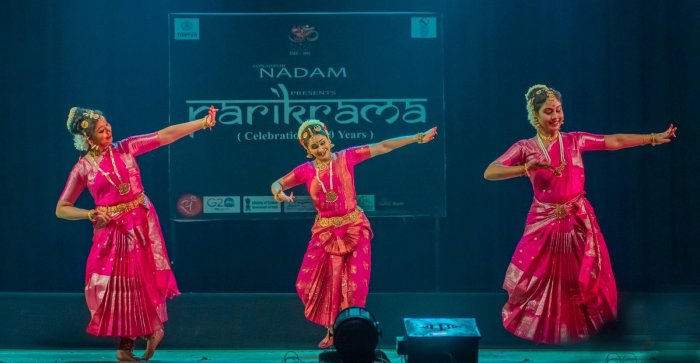 Akash Lingam Guru Kalamandalam Thankamani Kutty's disciples Satakshi Mukherjee, Ilina Basu and Anwesa Bhol did the honours of opening the festival with their guru's creation 'Akash Lingam' in Ananda Tandavam. The dance choreography is chiselled on the Akasha lingam in Chidambaram. The idol of Nataraja in his well-known dancing pose with one leg raised is enshrined in the holy sanctum of Chidambaram known as the Chit Sabha with a curtain behind it. Behind the curtain there is nothing but space, which represents Nirguna Brahman, devoid of all names and forms. This is the Chidambara Rahasyam. Lord Nataraja here is the attribute-less Brahman. It was a difficult topic to choreograph. Watching the piece composed in the inimitable pristine style of Bharatanatyam by the guru for me was aesthetic bliss; the piece was a pure delight for connoisseurs of dance. The clean lines and geometric movements with graceful torso manoeuvring that Bharatanatyam is known for were at its best. 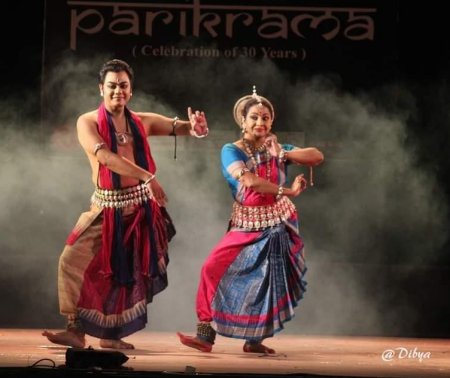 Shayomita Dasgupta and Subikash Mukherjee Hamsadhwani Pallavi choreographed and composed by Guru Kelucharan Mohapatra and Pandit Bhubaneswar Mishra has been a path breaking dance and music composition. The duo jointly reached their pinnacle of glory in all the dance pieces they jointly produced. Lucky are those that have learnt them painstakingly. When senior disciples of Odissi dance like Shayomita Dasgupta and Subikash Mukherjee render their guru's compositions, they are fulfilling the simple goal of passing down of knowledge from one generation to the next, thus maintaining the continuity of our oral tradition. However there is yet another aspect of guru-sishya parampara, where the boundaries of the art form are extended and taken forward, while at the same time not deviating from its roots. Subikash and Shayomita in rendering Hamsadhwani Pallavi fell under the first category of guru-sishya parampara, where knowledge is handed over untampered as imbibed from the guru. Shayomita and Subikash's second piece was danced to a composition of Dwinjendra Lal Roy's much loved lyric "Dhana dhanno pushpe bhara amader ayi basundhara", a people's song exemplified by reality, splendour, joyfulness of life, which is a part of the Bengali ethos. The dance was in a creative style with its roots in Odissi. Uma Dogra lived up to her renown. An instantaneous rapport with audience happened with the sound of the auspicious blowing of the conch shell followed by the chant of "Namah Shivaya". Holding the Shiva mudra, Uma and Sarita, her disciple, came into view dancing in joy, the Ananda Tandava, with the musical sound of the ankle bells creating quite a devotional aura. Having had the chance of seeing Uma Dogra's abhinaya pieces imbibed from the legendary Odissi dance guru, Guru Kelucharan Mohapatra in other venues, I eagerly waited to savour the rasa of what was to follow. She performed the ashtapadi "Sakhi hey keshi madana udaram." Composed by Jayadeva, it portrays Sri Krishna's love as described by the anxious and impatient heroine in the torment of her separation. She shyly recalls her "prathoma samagam" - intimate physical relationship - with Krishna and begs her Sakhi to bring him to her. Uma Dogra successfully enacted the piece charged with romance, with the power of her abhinaya. It was a mesmerizing piece shown in the aesthetic language of a Kathaka. 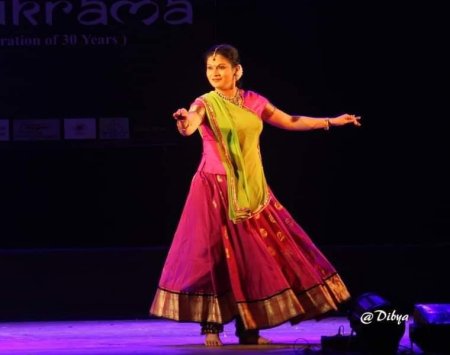 Sarita Kalele Sarita Kalele enthralled the rasikas in general and Kathak dancers in particular with the rendition of the Pancham Sawari, the 15th matra taal known as the soul of rhythms. This taal of fifteen beats is significant for its four sections. The first section has three beats and the remaining three sections have four beats in each. Three claps of this rhythm on first, fourth and twelfth beats and one waves or 'Khali' on eighth beat. The first beat of the whole rhythm is called 'sam'. Sarita sailed through this difficult taal to the awe of the audience. Her graceful pirouettes performed with elan, while wearing a soft smile all along won hearts. 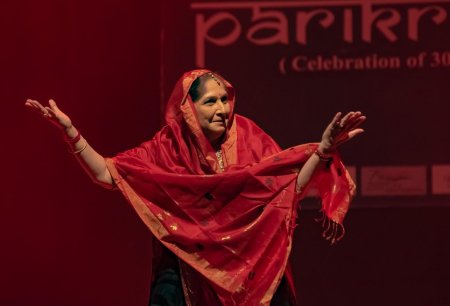 Uma Dogra as Manthara Uma Dogra then concluded their recital with her abhinaya of Manthara, into whose character the seasoned Kathaka immersed totally with the required concentration. Here she transformed into essaying the role of a character artiste. Her performance brought out the human ego which exists in all without any gender bias. Why should not Manthara seek power was the question that was implanted in the discerning audience. Why should not she hanker to achieve power? In a man's world her only claim to power would be through Bharata, the son of Kaikeyi, if he became the king of Ayodhya, because it was Kaikeyi to whom she was duty bound. Kaikeyi would lose her power of prominence should Kaushalya's son Ram be crowned king and indirectly so would she. She had to be discreet and so she was and as is wont she became a wicked hunchback and that is how Ramayana paints her to be. And of course to brand a person evil, who has a hunchback is nothing short of body shaming. Uma Dogra's portrayal of Manthara stirred up a hornet's nest in me. She is truly a Kathaka who can sail through the nine emotions that are necessary for the portrayal of any character. Without making a statement she said much worth pondering upon. 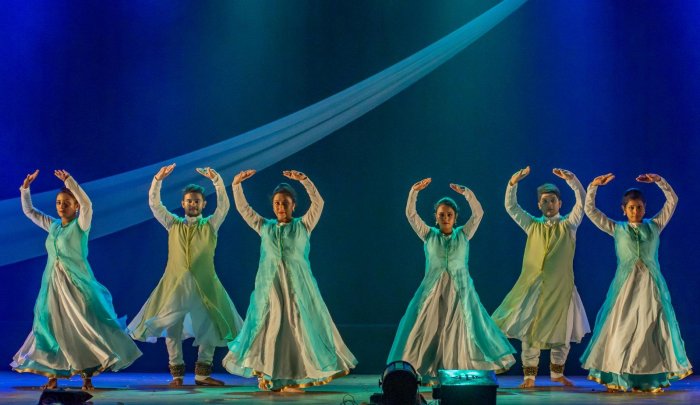 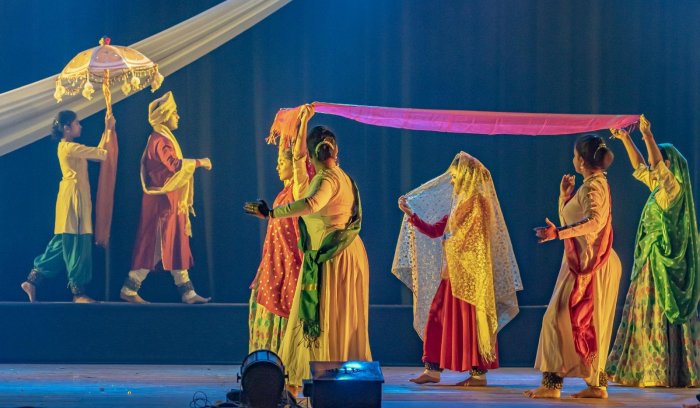 Bund 'Bund' conceptualized by Sandip Mallick was the last presentation of the festival. Life starts on water along with earth, fire, wind and space. Drops of water give birth to waterfalls, rivers, seas and the water under the earth. The river flows meandering through the land with its life giving waters, like a restless child. In the beginning it just trickles to gradually increase in size, also carrying waste matter which pollutes nature. In its flow it carries away all the filth of the world. In the name of progress it bears the burden of unplanned ventures time and again. It flows on till it reaches the ocean, only to begin a new life again with the other elements - earth, fire, wind and space - and give birth to new life. The many activities of human beings on the banks of rivers had given the sanrachana its richness. The tools used were the varied technical aspects of Kathak mastered with care. The script by Rupasree Mallick told the story of water to the melodious music composition of Sunando Mukherjee who also played the sarod. Subir Thakur's percussion accompaniment with vocal rendition of Arindam Bhattacharya, santoor support by Chirodeep Sarkar and flautist Rupak Mukherjee mesmerizing everyone created a beautiful evening. Voice over was by Pradip Roy while Bikash Sandhukha was on the keyboard. Bol parhant was by Sandip Mallick. The performers were Tandrani Pramamick Bose, Mondira Pal, Payel Majumdar Mallik, Tanusree Chanda Sett, Susanta Ghosh, Saheli Bagchi Das, Sourav Pal, Shubradip Shaw, Priyadarshini Sanyal, Meghamala Das, Arindam Dalui, Chinmoy Sikder, Risita Mondal, Suchandra Karmakar, Deepdas Malakar, Himali Roy, Ritwija Das, Anwita Mallik, Shresta Roy, Kamalika Mukherjee, Shuvom Mallick. Sandip Mallick created a beautiful environment in the engaging story of water. Though performed last and the night was no longer young, the audience remained glued to their seats. After the show gurus, writers, performers, scholars and rasikas spontaneously gathered on stage to commemorate the thirty golden years of Sonarpur Nadam. 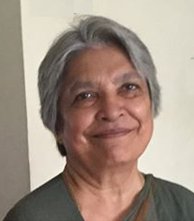 Tapati Chowdhurie trained under Guru Gopinath in Madras and was briefly with International Centre for Kathakali in New Delhi. Presently, she is a freelance writer on the performing arts. |